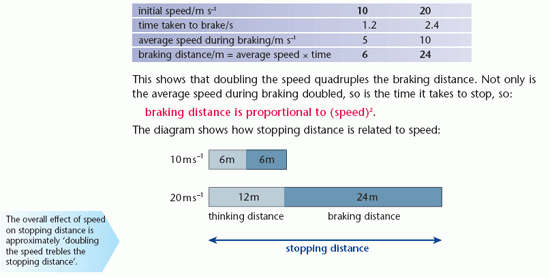Stopping Distances
In the highway code there is a chart that shows the stopping distances in good conditions for a car travelling at different speeds. There are two components to the stopping distance at a particular speed, thinking distance and braking distance.
Thinking distance is how far the vehicle travels while the driver is reacting. The two factors that determine this are:
- reaction time
- vehicle speed.
Drugs, including alcohol, nagging children and loud hi-fi can all increase a driver’s reaction time.
A driver’s reaction time depends on a number of things, including the state of the driver and the nature of the hazard, but a driver should be able to react to an unexpected hazard within 0.6 s.
During the driver’s reaction time the vehicle continues at a constant speed, so distance travelled = speed × time. Assuming a constant reaction time, this means that: thinking distance is proportional to speed.
As the diagram shows this means that doubling the vehicle speed doubles the thinking distance.
This is not the case with braking distance. As with reaction time, a number of factors could affect this, including the nature and condition of the road surface, the tyres and the brakes. The following calculations to work out the braking distances from speeds of 10 m s–1 and 20 m s–1 assume a deceleration of 8.3 m s–2.

